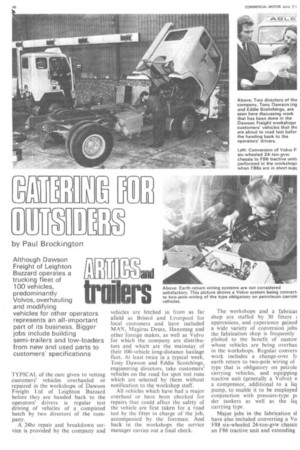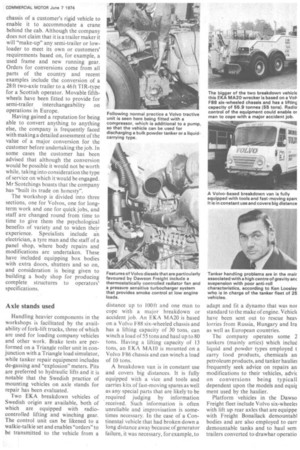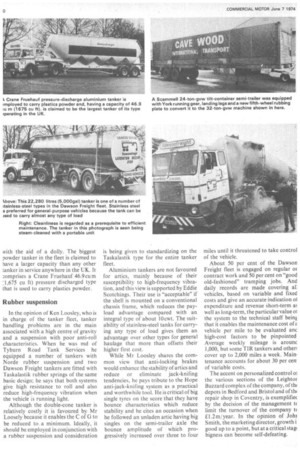by Paul Brockington
Page 50

Page 51

Page 52

If you've noticed an error in this article please click here to report it so we can fix it.
Although Dawson Freight of Leighton Buzzard operates a trucking fleet of 100 vehicles, predominantly . Volvos, overhauling and modifying vehicles for other operators represents an all-important part of its business. Bigger jobs include building semi-trailers and low-loaders from new and used parts to customers' specifications
TYPICAL of the care given to vetting customers' vehicles overhauled or repaired in the workshops of Dawson Freight Ltd of Leighton Buzzard before they are handed back to the operators' drivers is regular test driving of vehicles of a completed batch by two directors of the company.
A 24hr repair and breakdown service is provided by the company and
vehicles are fetched in from as far afield as Bristol and Liverpool for local customers and have included MAN, Magirus Deutz, flanomag and other foreign makes, as well as Volvo for which the company are distributors and which are the mainstay of their 100-vehicle long-distance haulage fleet. At least twice in a typical week, Tony Dawson and Eddie Scotchings, engineering directors, take customers' vehicles on the road for spot test runs which are selected by them without notification to the workshop staff.
All vehicles which have had a major overhaul or have been checked for repairs that could affect the safety of the vehicle are first taken for a road test by the fitter in charge of the job, accompanied by the foreman. And back in the workshops the service manager carries out a final check. The workshops and a fabricat shop are staffed by 30 fitters z apprentices, and experience gained a wide variety of conversion jobs the fabrication shop is frequently ploited to the benefit of custorr whose vehicles are being overhau in the Workshops. Regular convers work includes a change-over fr earth return to two-pole wiring of type that is obligatory on petrole carrying vehicles, and equipping tractive unit (generally a Volvo) a compressor, additional to a lig pump, to enable it to be employed conjunction with pressure-type pc der tankers as well as the lig carrying type.
Major jobs in the fabrication si have also included converting a Vo F88 six-wheeled 24-ton-gvw chassis an F86 tractive unit and extending chassis of a customer's rigid vehicle to enable it to accommodate a crane behind the cab. Although the company does not claim that it is a trailer maker it will "make-up" any semi-trailer or lowloader to meet its own or customers' requirements based on, for example, a used frame and new running gear. Orders for conversions come from all parts of the country and recent examples include the conversion of a 28 ft two-axle trailer to a 46ft TIR-type for a Scottish operator. Movable fifthwheels have been fitted to provide for semi-trailer interchangeability on operations in Europe.
Having gained a reputation for being able to convert anything to anything else, the company is frequently faced with making a detailed assessment of the value of a major conversion for the customer before undertaking the job. In some cases the customer has been advised that although the conversion would be possible it would not be worth while, taking into consideration the type of service on which it would be engaged. Mr Scotchings boasts that the company has "built its trade on honesty".
The workshop is divided into three sections, one for Volvos, one for longterm work and one for quick jobs, and staff are changed round from time to time to give them the psychological benefits of variety and to widen their experience. Specialists include an electrician, a tyre man and the staff of a panel shop, where body repairs and modifications are undertaken. These have included equipping box bodies with extra doors, shutters and so on, and consideration is being given to building a body shop for producing complete structures to operators' specifications.
Aisle stands used Handling heavier components in the workshops is facilitated by the availability of fork-lift trucks, three of which are used for loading company vehicles and other work. Brake tests are performed on a Triangle roller unit in conjunction with a Triangle load simulator, while tanker repair equipment includes de-gassing and "explosion" meters. Pits are preferred to hydraulic lifts and it is notable that the Swedish practice of mounting vehicles on axle stands for repair has been evaluated.
Two EK A breakdown vehicles of Swedish origin are available, both of which are equipped with radiocontrolled lifting and winching gear. The control unit can be likened to a walkie-talkie set and enables "orders" to be transmitted to the vehicle from a distance up to 100 ft and one man to cope with a major breakdown or accident job. An FK A MA20 is based on a Volvo F88 six-wheeled chassis and has a lifting capacity of 30 tons, can winch a load of 55 tons and haul up to 80 tons. Having a lifting capacity of 13 tons, an F K A MAW is mounted on a Volvo F86 chassis and can winch a load of 10 tons.
A breakdown van is in constant use and covers big distances. It is fully equipped with a vice and tools and carries kits of fast-moving spares as well as any special parts that are likely to be required judging by information received. Such information is often unreliable and improvisation is sometimes necessary. In the case of a Continental vehicle that had broken down a long distance away because of generator failure, it was necessary, for example, to adapt and fit a dynamo that was not standard to the make of engine. Vehick have been sent out to rescue heal/ lorries from Russia, Hungary and Ira as well as European countries.
The company operates some 2 tankers (mainly artics) which includ liquid and powder types employed t carry food products, chemicals an petroleum products, and tanker haulier frequently seek advice on repairs an modifications to their vehicles, advic on conversions being typical' dependent upon the models and equip ment used by the haulier.
Platform vehicles in the Dawso Freight fleet include Volvo six-wheeler with lift up rear axles that are equippe with Freight Bonallack demountabl bodies and are also employed to carr demountable tanks and to haul sem trailers converted to drawbar operatio with the aid of a dolly. The biggest powder tanker in the fleet is claimed to have a larger capacity than any other tanker in service anywhere in the UK. It comprises a Crane Fruehauf 46.9 cu m ;1,675 cu ft) pressure discharged type that is used to carry plastics powder.
Rubber suspension In the opinion of Ken Loosley, who is in charge of the tanker fleet, tanker handling problems are in the main associated with a high centre of gravity and a suspension with poor anti-roll characteristics. When he was md of Tyburn Road Tank Services he equipped a number of tankers with Norde rubber suspension and two Dawson Freight tankers are fitted with Taskalastik rubber springs of the same basic design; he says that both systems give high resistance to roll and also reduce high-frequency vibration when the vehicle is running light.
Although the double-cone tanker is relatively costly it is favoured by Mr Loosely because it enables the C of G to be reduced to. a minimum. Ideally, it should be employed in conjunction with a rubber suspension and consideration is being given to standardizing on the Taskalastik type for the entire tanker fleet.
Aluminium tankers are not favoured for artics, mainly because of their susceptibility to high-frequency vibration, and this view is supported by Eddie Scotchings. Their use is "acceptable" if the shell is mounted on a conventional chassis frame, which reduces the payload advantage compared with an integral type of about 1 Ocwt. The suitability of stainless-steel tanks for carrying any type of load gives them an advantage over other types for general haulage that more than offsets their higher first cost.
While Mr Loosley shares the common view that anti-locking brakes would enhance the stability of arties and reduce or eliminate jack-knifing tendencies, he pays tribute to the Hope anti-jack-knifing system as a practical. and worthwhile tool. He is critical of big single tyres on the score that they have bounce characteristics which reduce stability and he cites an occasion when he followed an unladen artic having big singles on the semi-trailer axle the bounce amplitude of which progressively increased over three to four miles until it threatened to take control of the vehicle.
About 50 per cent of the Dawson Freight fleet is engaged on regular ot contract work and 50 per cent on "good old-fashioned" tramping jobs. And daily records are made covering all vehicles, based on variable and fixed costs and give an accurate indication of expenditure and revenue short-term at well as long-term, the particular value oi the system to the technical staff beinE that it enables the maintenance cost of vehicle per mile to be evaluated anc high-cost factors to be pinpointed Average weekly mileage is arounc 1,000, but some T1R tankers and °then cover up to 2,000 miles a week. Main. tenance accounts for about 30 per cen. of variable costs.
The accent on personalized control oi the various sections of the Leightor Buzzard complex of the company, of tin depots in Bedford and Bristol and of tht repair shop in Coventry, is exemplifiec by the decision of the management tc limit the turnover of the company tt £1.2 tri/ year. In the opinion of Joh! Smith, the marketing director, growth i good up to a point, but at a critical stag' bigness can become self-defeating.




























































































































































